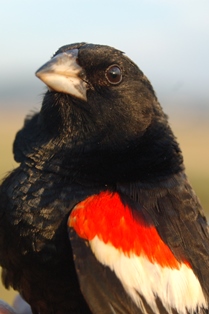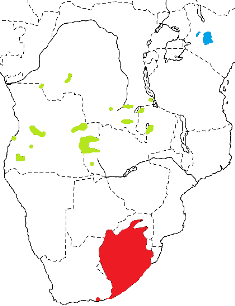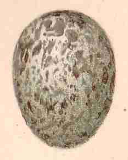Weaver Wednesday [82]: Long-tailed Widowbird 2014-01-08 (471)
 Weaver Wednesday
Weaver Wednesday



The Long-tailed Widowbird Euplectes progne is one of the most conspicuous grassland species where it occurs. The male in breeding plumage is unmistakable, with a tail up to 50 cm long (60 cm in Kenya). The bill is heavy and white (small and black in the Red-collared Widowbird, the shoulders are red and white (tawny brown in Jackson's Widowbird. Non-breeding males are by far the largest of the streaked widowbird species, with a floppy flight and broad
rounded black wings, still showing the red and buff epaulets; the tail length is variable, and the feathers pointed (rounded in Fan-tailed
Widowbird Euplectes axillaris. The female Long-tailed Widowbird is much smaller than the male. The female has narrower streaking on the back than the Fan-tailed Widowbird, and is best separated from Jackson's and Hartlaub's Marsh E. hartlaubi Widowbirds by the uniformly dark underwing-coverts.

The Long-tailed Widowbird occurs in southern and East Africa. Three subspecies are recognised (see map left, based on Birds of Africa):
E. p. progne in Botswana, South Africa, Swaziland and Lesotho (see red on map).
E. p. delamerei, in the highlands of Kenya (see blue on map). The male of this subspecies is longer-tailed.
E. p. delacouri, in DRCongo, Angola and Zambia (see green on map). The male of this subspecies has the upper mandible black rather than bluish, there is no white on the epaulet and the buff area is broader, and the wing longer.
Populations in Kenya are threatened by agricultural development of grassland areas within their limited range.
The Long-tailed Widowbird inhabits grasslands, often where grass is short, and not necessarily in marshy areas. It also occurs locally on coastal grasslands. It roosts communally in marshes even when breeding or in clumps of dense, high grass which may hold hundreds of birds of several species. Males flying to their roost site in the late afternoon fly high and fast; and claims that a male with a long tail is unable to fly in heavy rain or wind appear to be unfounded.
The diet of the Long-tailed Widowbird is mainly grass seeds. In the Free State, South Africa, the greatest variety of seed types are eaten in spring and winter. Nestlings are fed mainly with grass seeds, with arthropods about 25% by volume, including larvae, cicadas, aphids, beetles and spiders. The Long-tailed Widowbird forages mostly on the ground, where it both walks and runs, but hops on uneven surfaces. It Aaso hawks insects in flight. Males may leave their territory to feed.
The Long-tailed Widowbird is polygynous, and a male may have up to 5 females. Males are territorial, having favourite perches on fence posts, termite mounds or small trees. The male advertises his presence with a 'tsik' call from his perch, to which males on adjoining territories reply. Males pursue intruders in direct flight, with the tail streaming straight out behind. When a female enters his territory, he gives a highly characteristic flight display with a 'keeled' tail and laboured wingbeats, and epaulets conspicuous. Experimental manipulation of the tail length of a male suggests that females visit several territories in succession, and preferentially select the longest-tailed males.

The nest is woven of fine grass including growing green material. The nest is lined with flowering grass heads, which may project to form a short porch over the side entrance. The nest is sited close to the ground in a tuft of grass, with blades of grass bent over above the nest to form a bower, and concealing the nest. The male may make a simple nest ring, but it is the female that builds the nest for breeding, within a male's territory. The female continues to add lining during incubation, until the nest is densely padded. Nests are destroyed by people, raptors, rodents, driver ants and flooding.
2-3 eggs are laid, which are greenish white or blue-green, and heavily speckled with grey and olive-brown. The female incubates the eggs and feeds the young.
There are no PHOWN records for the Long-tailed Widowbird, other than a Nest Record Card from Angola (see PHOWN summary). Submit any weaver nest records to PHOWN (PHOtos of Weaver Nests) via the Virtual Museum upload site.
PHOWN summary
Previous Wedn: Bannerman's Weaver
Full weaver species list
|


 Weaver Watch
Weaver Watch


